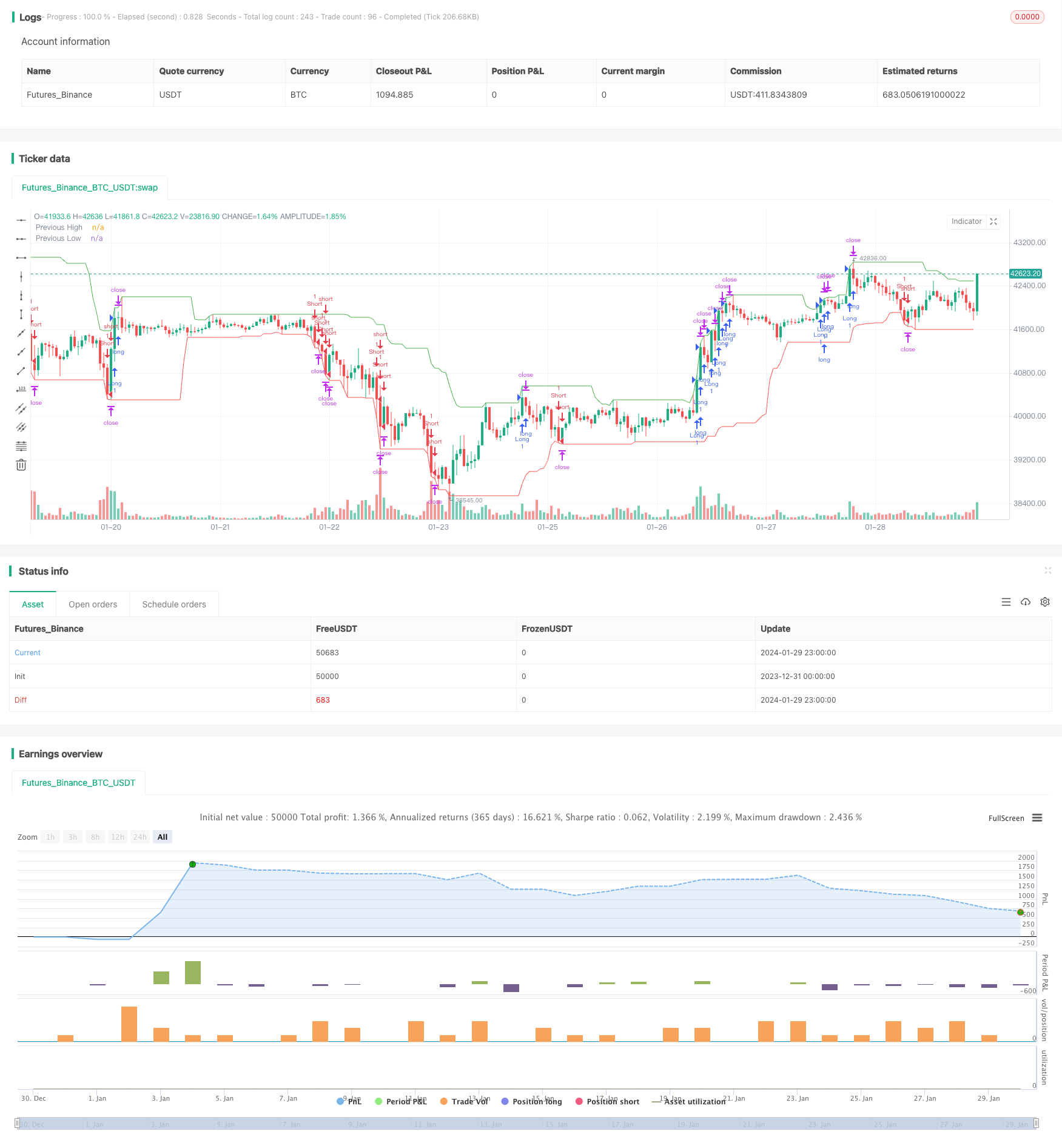
概述
该策略是一个基于动量指标的趋势跟踪突破交易策略。它通过计算一定周期内的最高价和最低价,判断市场趋势方向,并在价格突破关键价格位时进行买入或卖出操作。
策略原理
该策略的核心逻辑是:
使用highest()和lowest()函数计算最近20根K线的最高价和最低价,作为判断趋势的动量指标。
当最新收盘价超过上一周期最高价时,进行买入操作,进入多头仓位。此为向上突破信号。
当最新收盘价低于上一周期最低价时,进行卖出操作,进入空头仓位。此为向下突破信号。
为控制风险,设置1%的止损距离和2%的止盈距离。即盈亏比为2:1。
绘图显示最近20根K线内的最高价和最低价,以直观判断趋势方向和突破情况。
以上就是该策略的核心交易逻辑。它利用动量指标判断趋势方向,在价格突破关键价格位时进行操作,属于趋势跟踪突破交易策略。
策略优势
该策略具有以下优势:
捕捉趋势的方向和力度,针对性强。通过计算最高价和最低价判断趋势,只有在明确趋势形成后才入场,可以有效滤除震荡市的假信号。
操作简单清晰。仅基于突破最高价或最低价的逻辑进行买卖,容易理解和实现。
风险可控。设置止损和止盈距离后,最大亏损为1%,最大盈利为2%,盈亏比合理。
容易优化。可以调整计算最高最低价的周期参数,优化入场时机。也可以调整止损止盈参数,实现更大的盈利或更好的风险控制。
风险分析
该策略也存在一些风险:
可能出现止损被击穿的情况。当价格快速、大幅波动时,无法完全避免此风险。
趋势反转时无法及时平仓。计算最高最低价的周期越长,趋势判断滞后,可能错过趋势反转点位的操作时机。
参数设置不当可能无法实现盈利。计算周期和止损止盈距离需要仔细测试优化,否则无法获利。
优化思路
该策略可以从以下几个方面进行优化:
增加过滤条件,确保在趋势足够明确时才入场,避免不必要的交易。例如可以计算趋势指标,判断趋势强度。
调整计算最高最低价的周期参数,平衡趋势判断的及时性和稳定性。周期过短容易被短期波动误导,过长则趋势判断滞后。
添加止损追踪功能。以一定幅度追踪止损,可以锁定更多利润,同时也可以一定程度避免止损被击穿。
进行参数优化。可以通过历史回测,测试计算周期和止损止盈参数的不同组合,找到最优参数。
总结
该策略是一个较为典型的趋势跟踪突破交易策略。它利用动量指标判断趋势方向,在价格突破关键点位时进行操作。策略优点是简单清晰,风险可控,容易理解和优化。但也可能在某些市场环境下表现不佳。通过进一步优化,可以提高策略的稳定性和效率。
/*backtest
start: 2023-12-31 00:00:00
end: 2024-01-30 00:00:00
period: 1h
basePeriod: 15m
exchanges: [{"eid":"Futures_Binance","currency":"BTC_USDT"}]
*/
//@version=4
strategy("Trend Following Breakout Strategy with 2:1 RRR", overlay=true)
// 定义前高和前低的计算
length = input(20, minval=1, title="Length")
highestHigh = highest(high, length)
lowestLow = lowest(low, length)
// 定义买入和卖出的条件
longCondition = close > highestHigh[1] // 当前收盘价高于前一期的最高价
shortCondition = close < lowestLow[1] // 当前收盘价低于前一期的最低价
// 为了确保盈亏比为2:1,我们需要定义止损和目标价
stopLoss = input(1, title="Stop Loss %") / 100
takeProfit = stopLoss * 2
// 如果满足买入条件,进入多头
if (longCondition)
strategy.entry("Long", strategy.long)
strategy.exit("Long TP", "Long", profit=takeProfit * close, loss=stopLoss * close)
// 如果满足卖出条件,进入空头
if (shortCondition)
strategy.entry("Short", strategy.short)
strategy.exit("Short TP", "Short", profit=takeProfit * close, loss=stopLoss * close)
// 绘图显示前高和前低
plot(highestHigh, color=color.green, title="Previous High")
plot(lowestLow, color=color.red, title="Previous Low")